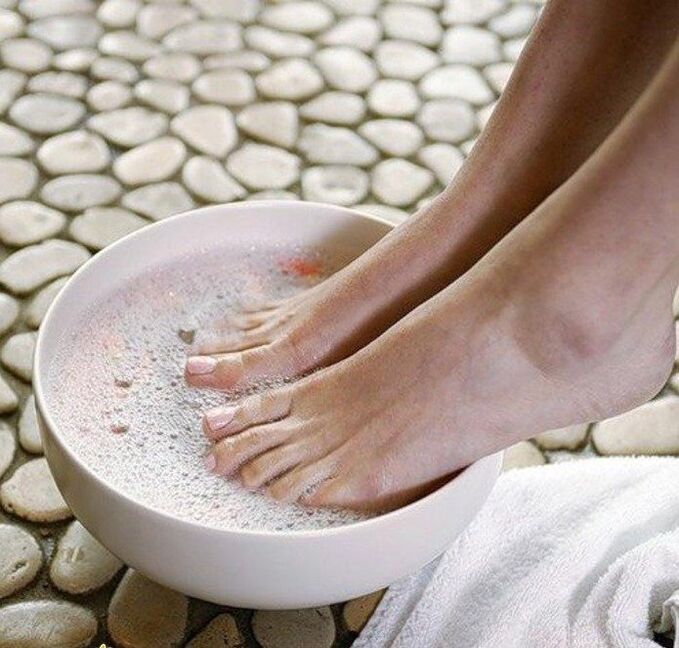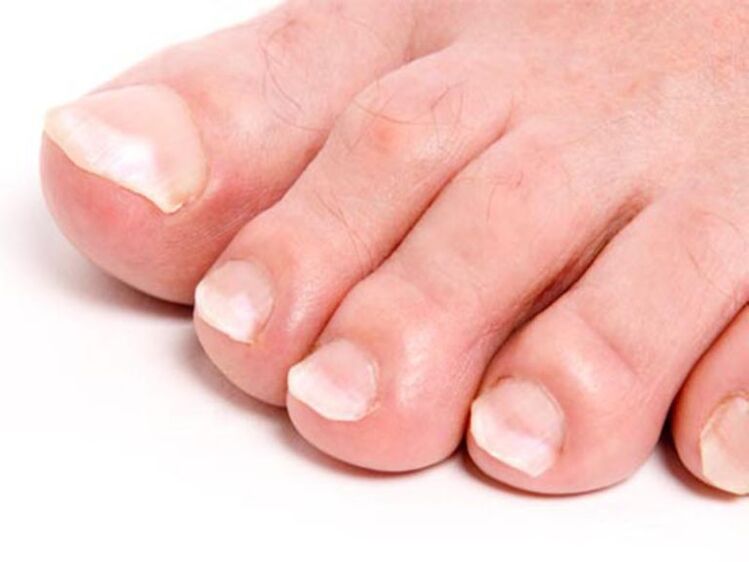
Nail fungus is a very unpleasant phenomenon. You can catch this disease, especially in the summer, anywhere. But the fight against it often takes a lot of time. A quarter of the world’s population, as statisticians say, suffers from this disaster. We will show you how to treat toenail fungus at home.
Vinegar for nail fungus
Not many people know that vinegar can be used to solve a relatively complex medical problem to get rid of nail fungus. Thanks to the availability of table vinegar (9%acid solution), as well as vinegar essence (70%acid solution), which can be purchased at hardware stores or on the market, there are many ways to treat toenail fungus using this product.
Of course, self-medication with vinegar should be carried out only if the disease does not turn into a neglected form, and it is advisable to combine it with specially developed drugs.
However, when there is an urgent need to treat nail fungus, and there is no money and time to visit a doctor, and there is no drug therapy, you can use vinegar yourself, the main thing is to adhere to appropriate safety rules.
Characteristics of the use of vinegar
The main effect of the use of vinegar is to create an acidic environment in the area of fungal infection, which inhibits the growth of hyphae and the spread of spores.
Gradually, the fungus, left without access to new nutrient sources, dies, and the absence of more resistant spores prevents the possibility of the disease recurring.
At first glance, everything is very simple - how to destroy bacteria with antiseptics. But in fact, the fungus turns out to be very strong, because its body is not located on the surface of the nail or skin, but goes into the thickness of the tissue.
In this case, a positive result of oncomycosis therapy should be expected only in the case of strict procedural regularity, which will not leave the parasite time for recovery and penetration under the skin.
Before treating nail fungus, make sure the concentration of acetic acid used is the same as shown in the recipe.
If the recipe contains a mention of the essence of vinegar, then it means a 70%solution, which must be dissolved or used according to the directions. Food vinegar or table vinegar, respectively, contain 6 and 9% acid. Ignoring these data can lead to the fact that treatment will end with chemical burns.
In addition to this, there are no special contraindications to treatment with vinegar. Individual intolerance is very rare, but vinegar is a common ingredient that usually patients are aware of this body feature.
A burning sensation may occur during the first procedure, but this is normal and will pass over time. Otherwise, vinegar, subject to safety regulations, does not pose any threat to health.
Vinegar bath

Warm foot baths are considered an effective remedy against fungus; regular use allows you to get rid of onychomycosis at an early stage without additional medication.
Also, a vinegar bath is an excellent prevention of fungal infections. This procedure requires warm, about 50 degrees, water and a glass of vinegar of 9%concentration.
The water level in the basin should not be high, but only up to the ankles. The legs are dipped in the solution and kept there for 15 minutes.
Before a vinegar bath, it is advisable to carry out a full pedicure procedure, including removal of the affected area on the nail plate and layers of dead skin, calluses and corns on the feet, but without applying a decorative coating on the nails.
If you cut and file your own nails, then you need to do it with caution, as micro damage to the skin can contribute to the spread of fungal infections.
Immediately after the vinegar bath, wipe your feet dry with a towel and wear cotton socks. Repeat three times a week.
Vinegar lotion
Lotion on the affected area of the fungus is best done after a vinegar bath.
For this, both pharmaceutical products and 9% pure vinegar are suitable, in which a cotton pad is moistened and applied on the nail for fifteen minutes.
More complex recipes: a mixture of vodka or medical alcohol of forty degrees, glycerin and 70% acetic acid in equal proportions, mix until smooth.
A cotton swab, moistened with a solution, is kept for fifteen minutes on the affected area, after which they put on socks made of cotton material. The course of treatment is a week, if necessary, you can repeat it after a few days.
Ointment against fungus on the feet
All available local preparations are based on the following active ingredients:
- bifonazole;
- sertocanazole;
- ketoconazole;
- terbinafine;
- naftifine;
- oxyconazole;
- cyclopiroxolamine.
The choice of ointment for toenail fungus is carried out only after scraping the skin or the top of the nail. Based on the results of the analysis, it becomes clear which of the types of pathogenic microorganisms are the causative agents of mycosis:
- epidermofit;
- trikoton;
- dermatophyte;
- microspores;
- mold fungi;
- mushrooms like yeast.
Based on the results of the diagnosis, you should buy the best ointment that can combat the detected fungal pathogens.
Antifungal ointment
All antifungal agents designed to get rid of nail fungus are divided into 2 groups:
- Allylamine. These drugs penetrate deep into the nail plate, destroying the fungal colonies completely. After a course of treatment, the concentration of the accumulated active ingredient helps to withstand recurrence for a long time, healthy nails grow in place of nails affected by the fungus.
- Azole. They interfere with fungal synthesis by destroying cell membranes. The effect of drug accumulation in the nail plate leads to complete death of the infection.
If the affected nail area is still quite small, you can get rid of the fungus with a special nail polish.
The funds are used as a regular pedicure varnish, applied in a thin layer directly to the affected nails twice a week.
For prophylaxis, healthy nails on neighboring fingers should also be varnished, as fungal spores spread quickly and easily in space.
Inventory procedure

These guidelines will help you use the ointment against fungus more effectively.
- If the fungus has infected several areas on your body, then it should be treated at the same time to prevent recurrence of the disease.
- Apply the ointment not only on the affected nails or skin, but also to the area adjacent to it.
- During the period of using the ointment, observe strict hygiene, both the affected skin area and the whole body as a whole.
- Before using the medicine, clean the affected area with antibacterial soap under running water. Then shower gently. To do this, dilute 1-2 tablets of furacilin or potassium permanganate in 5 liters of warm boiled water. Soak your hands or feet in the solution for 10-15 minutes.
If, after a few weeks of using the drug, the first signs of withdrawal of the disease do not appear, it is necessary to change the ointment and consult a dermatologist.
Ointment with naftifine
Antifungal cream with the active ingredient naftifine hydrochloride, which contributes to the disruption of the structure of the cell wall of the infection. Diffuses into deep layers of skin. It also exists in the form of a solution.
It is used in the treatment of foot fungus, nails, various lichens on the body. The agent is applied to the affected surface, cleaned and adjacent areas once a day.
The duration of the course is from a few to eight weeks with fungus on the skin. With nail infections, it is used several times a day for six months.
Contraindications in hypersensitivity to naftifine. Sometimes it can cause redness and burning of the skin, but you should not interrupt the treatment.
Terbinafine ointment
One of the safest and most effective antifungal agents. Perhaps this is due to the active ingredient terbinafine.
The ointment is applied in a thin layer at the base of the nail and on adjacent skin areas and rubbed. This procedure is repeated 1-2 times a day.
The course of therapy lasts from 14 days to 1 month. Usually, the first results can be seen after the first two weeks. If no improvement is observed, then it is recommended to replace the agent with another drug. The drug is allowed for adults and children from 2 years.
Ketoconazole ointment
This medication is most effective for yeast infections, especially on the skin. Ketoconazole - the main active ingredient of the ointment, penetrates into the inner layers of the skin and acts directly in fungal cells, inhibiting their reproduction and causing death.
Good because it quickly relieves fungal symptoms. It is used once a day for a month if the lesion is localized on the hand, and up to two months if it is localized on the foot.
Clotrimazole ointment
An effective antifungal remedy is a cream used to treat nail plates and skin. The main component of the drug is clotrimazole, which destroys fungal membranes, and this leads to their death, applied to diseased nails twice a day.
The duration of treatment depends on the stage of development of the disease. But even after the disappearance of his symptoms, treatment should be continued for a month.
Ointment is contraindicated in cases of individual intolerance to its components and liver disease.
Cheap ointments: salicylic, zinc and sulfuric acid
Salicylic ointment can be used to successfully treat toenail fungus. It is used in two ways. In the first case, it is rubbed on the affected area with a thin layer.
In the latter case, using an ointment, compresses are made at night. After such a procedure, the skin on the feet will begin to peel off strongly. Bathing soap and soda will help speed up the exfoliating process.
Sulfur ointment is an old proven remedy against nail fungus. It is used once a day at night for a week, the concentration of which is set by the doctor individually.
It is a strong allergen, therefore, before use, it is necessary to test healthy skin areas.
Tea tree oil against fungi

Tea tree oil is an effective remedy against onchomycosis, acting directly on the cause of the disease - dermatophyte fungi.
Tea tree essential oil contains alpha-terpinene, alpha-fellandrene, limonene, sabinene, cineole and other substances that provide its antiseptic and anti-inflammatory properties.
Before using essential oils, it is necessary to conduct an allergy test - apply a small amount of the product on the skin of the wrist, if no irritation, redness rash and other reactions occur within 12 hours, then the product can be used for medical purposes.
Otherwise, it must be diluted to a safe concentration, or this technique must be abandoned altogether.
How to use tea tree oil:
- Tea tree oil foot bath. Warm water is poured into the basin to ankle level, 15-20 drops of essential oil are added and the feet are kept in it for twenty minutes, maintaining a high water temperature (45-50 degrees). The course of treatment is two months, you need to do a bath every day. During the treatment procedure, it is necessary to remove the affected area on the nail plate using a file, nail clippers or scissors.
- Apply oil on the nail plate. If you do not have a reaction to undiluted tea tree oil, then to increase the effectiveness of its effect, it is applied in pure form to the affected nail area. Previously, the legs were steamed in warm water with the addition of washing soap (for better dissolution, it could be grated). The oil is rubbed into the nail plate with a cotton swab twice a day, no need to wash the product.
How to cure toenail fungus fast
The internal and external uses of hydrogen peroxide for the treatment of infectious and other diseases are explained by Professor Neumyvakin in a book written based on personal experience.
He called hydrogen peroxide a prophylactic agent with antibacterial properties.
External application of hydrogen peroxide for the treatment of fungal infections is carried out after steaming the feet in warm water with dissolved soda at the rate of one teaspoon per liter.
When the nail plate becomes soft, pinch a small fragment of the affected nail area using nail clippers and, soaking with a 3%peroxide solution, apply on the nail plate.
Let act for 10-15 minutes on nails or from 40 minutes to an hour on feet. Perform the procedure twice a day until the symptoms of the fungal infection disappear.
To reduce peroxide evaporation and increase the intensity of the effect, the nail plate with lotion was wrapped with plastic wrap.
After the exposure time has elapsed, rinse your toes and hands thoroughly under running water.
For therapeutic and prophylactic purposes, it is recommended to implant the nail cavity with hydrogen peroxide three times a day.
Good results are given by bathing for hands and feet (depending on the localization of onychomycosis) with hydrogen peroxide.
Dissolve 3% hydrogen peroxide in water at a temperature of 40-50 degrees at the rate of two tablespoons per liter of water. The time of the procedure is fifteen minutes, the regularity of the procedure is twice a day for a week.
Other folk remedies
Comprehensive treatment of toenail fungus using folk recipes based on hydrogen peroxide allows you to destroy the fungus and permanently get rid of unpleasant odors and other accompanying symptoms.
Two effective folk remedies for fungal infections:
- Recipe with Peroxide 1. To prepare the mixture, you need slaked soda (0. 5 cups), hot water (4 cups), 3% hydrogen peroxide (0. 25 cups), and half a cup of magnesium sulfate or Epsom salt. Mix all ingredients thoroughly and add a quarter cup of vinegar. Soak the cotton with the resulting solution and apply it to the nail plate affected by the fungus with plaster. Bandages need to be renewed every ten hours, the course of treatment is a month.
- Peroxide recipe 2. The procedure for treating fungus according to this recipe consists of three stages. First, it is necessary to prepare a solution for treating the surface of nails and skin affected by the fungus - mix 3% vinegar and peroxide in a concentration of 3% in a ratio of 1: 1. This mixture is applied on the feet while it sizzles. The second stage is to soak the fingers with a fungal infection on the nails for half a minute in a weak bleach solution in water, after which they are rinsed thoroughly under running water and wiped dry with a towel. In the end, tea tree oil mixed with petroleum jelly in equal proportions is applied on the nail plate. Wear warm socks or gloves (if this technique is used to treat nail cancer). The course of treatment is one week.
- Novocaine lotion. A very simple but effective folk remedy in the treatment of fungus is novocaine lotion. Just soak a piece of cotton wool with novocaine and apply on the fungus overnight. Just two such lotions are enough to get rid of the fungus forever.
- Colored apricot resin: 1 tablespoon of resin removed from the tree, pour a glass of vodka, leave for three days. Lubricate the skin of the feet and nails with this solution. Shake well before each use. We took a month for treatment, the affected nails were cut as they peeled off, new and healthy ones grew. On examination, the doctor confirms the fact of recovery. I can also recommend using old and concentrated sunflower oil in this case.
- Garlic application: I take a clove of garlic, squeeze it with a garlic maker, put the mass on the nail, cover it with cellophane and wrap it with a bandage or put on the fingertips. I left the bandage on until morning, the first few days I felt a throbbing pain, like an abscess, but I had to persevere. The procedure is repeated daily and new nails grow.
- Concentrated coffee. Some people know that ordinary, but strong coffee is an excellent folk remedy for treating fungus. Make your coffee stronger and just dip your hands or feet into the cup, depending on where you have the fungus. This procedure is best done in the evening, before bed. The fungus disappeared completely after several such evening procedures. At the same time, the skin becomes smooth, and the pain passes quickly.
















